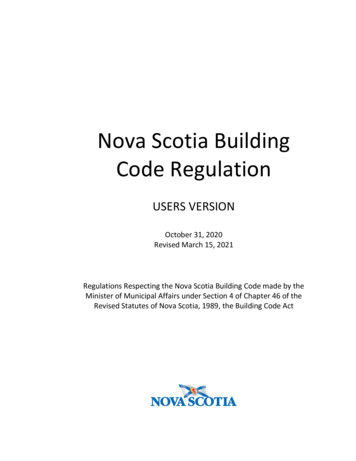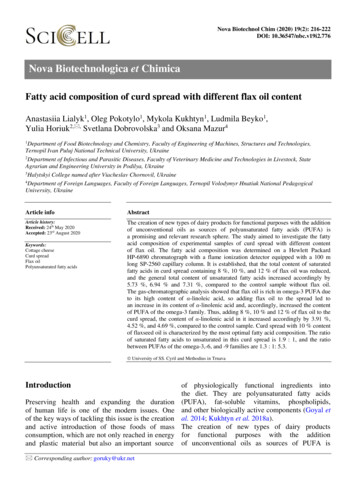
Transcription
Nova Biotechnol Chim (2020) 19(2): 216-222DOI: 10.36547/nbc.v19i2.776Nova Biotechnologica et ChimicaFatty acid composition of curd spread with different flax oil contentAnastasiia Lialyk1, Oleg Pokotylo1, Mykola Kukhtyn1, Ludmila Beyko1,Yulia Horiuk2, , Svetlana Dobrovolska3 and Oksana Mazur41Department of Food Biotechnology and Chemistry, Faculty of Engineering of Machines, Structures and Technologies,Ternopil Ivan Puluj National Technical University, Ukraine2Department of Infectious and Parasitic Diseases, Faculty of Veterinary Medicine and Technologies in Livestock, StateAgrarian and Engineering University in Podilya, Ukraine3Halytskyi College named after Viacheslav Chornovil, Ukraine4Department of Foreign Languages, Faculty of Foreign Languages, Ternopil Volodymyr Hnatiuk National PedagogicalUniversity, UkraineArticle infoAbstractArticle history:Received: 24th May 2020Accepted: 23rd August 2020The creation of new types of dairy products for functional purposes with the additionof unconventional oils as sources of polyunsaturated fatty acids (PUFA) isa promising and relevant research sphere. The study aimed to investigate the fattyacid composition of experimental samples of curd spread with different contentof flax oil. The fatty acid composition was determined on a Hewlett PackardHP-6890 chromatograph with a flame ionization detector equipped with a 100 mlong SP-2560 capillary column. It is established, that the total content of saturatedfatty acids in curd spread containing 8 %, 10 %, and 12 % of flax oil was reduced,and the general total content of unsaturated fatty acids increased accordingly by5.73 %, 6.94 % and 7.31 %, compared to the control sample without flax oil.The gas-chromatographic analysis showed that flax oil is rich in omega-3 PUFA dueto its high content of α-linoleic acid, so adding flax oil to the spread led toan increase in its content of α-linolenic acid and, accordingly, increased the contentof PUFA of the omega-3 family. Thus, adding 8 %, 10 % and 12 % of flax oil to thecurd spread, the content of α-linolenic acid in it increased accordingly by 3.91 %,4.52 %, and 4.69 %, compared to the control sample. Curd spread with 10 % contentof flaxseed oil is characterized by the most optimal fatty acid composition. The ratioof saturated fatty acids to unsaturated in this curd spread is 1.9 : 1, and the ratiobetween PUFAs of the omega-3,-6, and -9 families are 1.3 : 1: 5.3.Keywords:Cottage cheeseCurd spreadFlax oilPolyunsaturated fatty acids University of SS. Cyril and Methodius in TrnavaIntroductionPreserving health and expanding the durationof human life is one of the modern issues. Oneof the key ways of tackling this issue is the creationand active introduction of those foods of massconsumption, which are not only reached in energyand plastic material but also an important source Corresponding author: goruky@ukr.netof physiologically functional ingredients intothe diet. They are polyunsaturated fatty acids(PUFA), fat-soluble vitamins, phospholipids,and other biologically active components (Goyal etal. 2014; Kukhtyn et al. 2018a).The creation of new types of dairy productsfor functional purposes with the additionof unconventional oils as sources of PUFA is
Nova Biotechnol Chim (2020) 19(2): 216-222a promising and relevant research sphere(Bermúdez-Aguirre and Barbosa-Cánovas 2011;Ganesan et al. 2014; Dal Bello et al. 2015).On the one hand, it is because of the presenceof lactic acid microorganisms, which providea useful antagonistic effect on the conditionallypathogenic gut flora (Prado et al. 2015; Kukhtyn etal. 2018b), and on the other hand, due tothe increased content of PUFA, especiallythe omega-3 family, namely linoleic acid, whichcover the deficit of these fatty acids in the diet(Lane et al. 2014; Dal Bello et al. 2017).This approach in the technological introductionof flax oil gives the prospect of making enrichedcheese paste a biologically valuable functional foodproduct.It is known that PUFAs of the omega-3 familyenter our body either with fat from the fish of coldseas(whichareeicosapentaenoicand docosahexaenoic fatty acids) or with vegetableoils such as flax, sesame, rapeseed, pumpkin,soybeans, and others, which contain differentamounts of linoleic acid 2017). Reference data (Asuming-Bediako et al.2014; Suksombat et al. 2014; Ayyildiz et al. 2015;Lewinska et al. 2015) indicates that sunflowerand corn oils contain a high amount of ω-6 acidsand very small amount of ω-3 acidsand, accordingly, do not have the appropriate onsumptionratioof ω-3/ω-6 PUFA (1 : 10). Rapeseed and mustardoils are characterized by a relatively low levelof saturated fatty acids (4 – 7 %), a high levelof oleic acid (33 – 59 %) and an average levelof linolenic acid (9 – 11 %) and, accordingly,a favorable ratio of ω-3/ω-6 as 1: 1 – 2. Olive oil ischaracterized by a high content of oleic acidand a low level of PUFA. The content of essentialα-linolenic acid in flax oil significantly exceedsthe recommended levels, which indicates their highphysiological value and feasibility of use as a lipidsupplement to enrich food with ω-3 acid. Essentialγ-linolenic acid (18 %) was detected only in cedaroil. Walnut and hemp oils have a fairly highcontent of α-linolenic acid, but their use is limitedby high cost and low prevalence. Therefore,scientists (Goyal et al. 2014; Lewinska et al. 2015;217Kanakri et al. 2017) believe that flaxseed oil in itsbiological value is in the first place to providethe body with omega-3 PUFA and recommend itenter into the daily diet.The adequate content of PUFAs of the omega-3family in the diet provides a whole rangeof functions in a healthy body due to the high,genetically determined content of these PUFAsin the membranes of all cells and the main poolsof the organism (El Abed et al. 2008; AlbrachtSchulte et al. 2018; DiNicolantonio and O’Keefe2018). Also important is their role as derivativesfor the formation of cellular hormones, such asprostaglandins, leukotrienes, and thromboxanes,which regulate the course of physiologicaland biochemical processes in cells and tissues bothin normal and in various pathologies (Gogus andSmith 2010; Browning et al. 2012; Calder 2015).Therefore, PUFAs, which are rich in omega-3s, arenow regarded as "healthy fats" with severalphysiological benefits. In particular, consumptionof products with such content helps to maintainthe physiological level of triglycerides in the bloodand blood pressure prevents the developmentof cardiovascular diseases (Chowdhury et al. 2014;Farvid et al. 2014). Also, it has been reported thatregular consumption of omega-3 fatty acids hasa positive effect on the brain and nervous systemactivity (Gogus and Smith 2010; Drapkinaand Shepel 2015).Based on the above mentioned, we have developeda curd spread with additional content of flax oil asa source of omega-3 PUFAs (Lialyk et al. 2019).The study aimed to investigate the fatty acidcomposition of cottage cheese, flax oil,and developed curd spread with different contentof flax oil.ExperimentalThe work was carried out at the TernopilIvan Puliuj National Technical Universityin the laboratories of the Department of FoodBiotechnology and Chemistry.In the process of developing the technologyof a particular food product, especially with highfat content, it is advisable and importantto determine the fatty acid composition of sucha product. To create the curd spread according
Nova Biotechnol Chim (2020) 19(2): 216-222to the recipe low-fat cottage cheese was chosen,which meets the requirements according tothe requirements of SSU (State Standardsof Ukraine) (SSU 2007). In the first stageof the experimental part of the study, the fatty acidcontent of raw milk and the cottage cheeseof the trademark "Molokiia" (which was used asa basis for the production of curd spread richin omega-3 fatty acid) were investigated.In the second stage, the fatty acid content of flax oilwas investigated. On the third stage, the fatty acidcomposition of curd spread with a flax oil contentof 8 %, 10 %, and 12 % was investigated. Gaschromatographic analysis of raw milk, low-fatcottage cheese of trademark "Molokiia", flax oiland curd spread with different content of flax oilwas investigated using gas-liquid chromatographyon Hewlett Packard HP-6890 gas chromatographwith flame-ionization detector equipped with opentubular column SP-2560 with a length of 100 m(Holubets and Vudmaska 2015).The process of making curd spread with linseed oilincluded the following technological operations:1) Selection of a mixture for melting (low-fatcottage cheese and linseed oil were subjectedto organoleptic evaluation and laboratory methodsof quality research); 2) Grinding of raw materials(raw materials were grounded into particleswithadiameterof5–8mm).3) Compounding of the mixture. 4) Introductionof melting salts (melting salts-sodium citrate wasadded to the cheese mass to increase the pH, partialtransition of proteins to the soluble stateand improve the melting process of the cheesemass); 5) Maturation of curd mass (durationof exposure 2 h); 6) Melting of the curd mass(melting time 15 min, at a temperature of 82 C(PS-10,“Ukrtechprom”Ukraine));7) Homogenization of the melted mass (durationof homogenization at P 9.81 MPa onMICROTRON MB 800, Germany); 8) Packaging(packaging of the curd product was carried outin hot way at a temperature of 60 – 75 C in foil.The weight of the package is 50 g). 9) Coolingand storage of the curd product (up toa temperature of 2 – 4 C).Statistical processing of the results was carried outusing methods of variation statistics usingthe program Statistica 9.0 (StatSoft Inc., USA).Non-parametric methods of research were used(Wilcoxon-Mann-Whitney test). The arithmeticmean (x) and the standard error of the mean (SE)were determined. The difference betweenthe comparable values was considered to besignificant for P 0.05.Results and DiscussionAs a result of gas chromatographic analysis of milkfat, 39 peaks were found, which correspondedTable 1. The fatty acid composition of low-fat cottage cheese of trademark "Molokiia" and raw milk materials (x SE, n 5).Name of fatty icMyristicPalmiticStearicOther acidsIn total nicOther acidsIn total unsaturatedCode of fatty acidsMass content of fatty acids [%]Cottage cheeseControl sample, raw milkС4:0С6:0С8:0С 10 : 0С 12 : 0С 14 : 0С 16 : 0С 18 : 03.16 0.111.82 0.131.03 0.072.60 0.112.67 0.0711.45 0.1233.62 0.149.75 0.116.76 0.1072.86 0.143.55 0.122.10 0.081.14 0.062.41 0.112.66 0.0811.45 0.1233.44 0.159.68 0.166.56 0.1172.98 0.16С 18 : 1С 18 : 2С 18 : 3С 20 : 422.07 0.023.751 0.0120.845 0.1000.07 0.030.42 0.0927.14 0.1621.67 0.013.69 0.010.83 0.000.06 0.000.77 0.0727.12 0.12218
Nova Biotechnol Chim (2020) 19(2): 216-222to saturated and unsaturated fatty acids and theirisomers. Table 1 shows the main fatty acids. Fromthe presented data it can be seen that in the low-fatcottage cheese of trademark "Molokiia". Palmitic,myristic, and stearic acids were dominant amongsaturated fatty acids, whereas oleic and linolenicwere dominant among unsaturated fatty acids.The ratio between saturated and unsaturated fattyacids in low-fat cottage cheese of the trademark“Molokiia” was 2.7 : 1. It should be noted thatamong unsaturated fatty acids in cottage cheese,polyunsaturated fatty acids of the omega-6 familyare dominated, accounting for 26 % of the totalof all fatty acids or 96 % of polyunsaturated fattyacids. The analysis of the obtained results showsthat this cottage lacks the polyunsaturated fattyacids of the omega-3 family. The contentof the latter in this study product is only 0.8 %of all fatty acids. Thus, it can be argued that thiscottage cheese is deficient in the content of PUFAsof the omega-3 family. Therefore, when creatinga curd spread based on this cottage cheese, our taskwas to enrich its PUFA of the omega-3 family.For the enrichment of cottage cheese withomega-3 PUFA in the process of making curdspread, we have chosen flax oil, which is known tobe one of the richest in omega-3 family PUFAbecause of its high content of α-linolenoic acid.Since the fatty acid composition of oils, includingflax oil, depends on many characteristics, we havechosen flax one, which is made from seeds of the“Debiut” breed and its fatty acid composition wasinvestigated. The results obtained are presentedin Table 2. As can be seen, flax oil obtained fromthe seeds of flax breed "Debiut" is characterizedby a high content of the omega-3 family PUFA dueto linolenoic acid, which is 53.5 % of the totalcontent of all fatty acids. The ratio of PUFAsof the omega-3, -6, and -9 families in the studiedflax oil is 4 : 1 : 1.5. In general, the resultsof the study of the fatty acid composition of flax oilconfirm the high content of α-linolenoic acid,which allows it to be reasonably used forthe enrichment of curd spread.The next stage of our research was the developmentof technology for the production of curd spreadwith different contents of flax oil. The samplesof cottage cheese products contained 8 %, 10 %,and 12 % of flax oil. As a result, curd products hada creamy-white color that was smooth all overand with specific for curd and slightly mustard-liketaste of flax oil, without excess acidity taste.The results of the study of the fatty acidcomposition of curd spread with different flax oilcontent are presented in Table 3.Table 3 shows that the fatty acid compositionof the studied curd spreads varied significantlydepending on the content of flax oil. Thus,in general, in all tested samples of curd spread withthe addition of 8 %, 10 % and 12 % of flax oilthe content of such saturated fatty acids as palmiticand stearic increased and the content of other, lowmolecular acids, such as oil, caprylic, capronic,caprinic, lauric and myristic, decreased. In general,the total content of saturated fatty acids in the curdspread with the addition of 8 %, 10 % and 12 %of flax oil decreased by 5.73 %; 6.94 % and 7.31%, respectively compared to the control sample(without flax oil). The content of unsaturated fattyacids according to Table 3, respectively, increasesdue to oleic, linolic, and linolenoic acids, and thisincrease is directly correlated with the increasein the content of flax oil in curd spread. These fattyacids are a key factor to a particular classof omega-3, -6, or -9 polyunsaturated fatty acids,Table 2. The fatty acid composition of linseed oil by the so the ratio between these classes of omega PUFAsmethod of cold-pressed flax seeds "Debiut" (x SE, n 5).has changed accordingly. The general total contentContent of fattyName of fattyCode of fattyof unsaturated fatty acids in curd paste withacid [%]acidsacidsthe addition of 8 %, 10 % and 12 % of flax oiltrace amountincreased by 5.73 %; 6.94 % and 7.31 %,MyristicС 14 :0PalmiticС 16 : 07.40respectively compared to the control sampleStearicС 18 : 04.20of curd spread without the addition of linseed oil.ArachidicС 20 : 40.50Considering that flax oil is rich in omega-3 PUFAPalmitelaidicC 16 : 10.20due to the high content of α-linolenic acid,OleicС 18 : 1с21.40LinolicC 18:2c,12c12.80the addition of flax oil in the spread, in the firstLinolenoicС 18:3c,12c, 15с 53.50place, will lead to an increase in the content219
Nova Biotechnol Chim (2020) 19(2): 216-222Table 3. The fatty acid composition of curd spread (CS) with different flax oil content (x SE, n 4).Mass content of fatty acids [%]Name of fatty acidSaturatedMaslinic, С 4 : 0Capronic, С 6 : 0Caprilic, С 8 : 0Caprinic, С 10: 0Lauric, С 12: 0Myristic С 14: 0Palmitic С 16: 0Stearic С 18: 0Other acidsIn total saturetedUnsaturatedOleic С 18 : 1 (ω -9)Linolic С 18 : 2 (ω-6)Linolenoic С 18 : 3 (ω-3)Arachidonic С20 : 4 (ω-6)Other acidsIn total unsaturetedTotal omega-3Total omega -6Total omega -9ω-3/ ω-6The ratio of saturated to unsaturated FAs* Р 0.05 – compared to control.Control sample of CSwithout flax oilCS with 8 %of flax oilCS with 10 %of flax oilCS with 12 %of flax oil3.21 0.421.82 0.111.03 0.012.60 0.192.67 0.0211.45 0.0933.62 0.219.75 0.086.76 0.1372.91 0.542.52 0.24*1.25 0.15*0.72 0.07*2.16 0.13*2.03 0.25*10.12 0.1234.04 0.1810.06 0.115.04 0.2767.18 0.522.16 0.19*0.78 0.13*0.61 0.05*1.77 0.21*1.63 0.17*9.86 0.2434.19 0.2810.15 0.224.82 0.3665.97 0.342.04 0.21*0.63 0.14*0.54 0.04*1.52 0.18*1.54 0.16*9.72 0.1835.04 0.3510.03 0.184.54 0.1065.60 0.3722.01 0.253.75 0.120.85 0.060.07 0.010.41 0.0227.09 0.250.85 0.063.82 0.1222.01 0.251 : 4.52.7 : 123.05 0.023.97 0.154.76 0.120.07 0.010.21 0.0332.06 0.364.76 0.124.04 0.1523.05 0.021.17 : 12.1 : 123.52 0.134.40 0.265.77 0.020.06 0.020.28 0.0534.03 0.265.77 0.024.46 0.2623.52 0.131.29 : 11.9 : 123.57 0.144.51 0.336.04 0.310.06 0.010.22 0.0334.40 0.276.04 0.314.57 0.3323.57 0.141.32 : 11.9 : 1of α-linolenic acid and, accordingly, an increase ofthe content of omega-3 family PUFA. Thus, when8 %, 10 %, and 12 % of flax oil is added to the curdspread, the content of α-linolenic acid in the curdspread increases by 3.91 %; 4.52 % and 4.69 %,respectively compared to the control sample.We support the view of researchers (Sioen et al.2009; Vella et al. 2013) that the consumptionof products containing PUFA of the omega-3in the world is insufficient to provide at least 10 %of the daily rate of the recommended consumptionof 2 g/day of α-linolenic acid according toEU Regulation No. 1924/2006 and No. 432/2012.Therefore, the development of curd spread withflax oil content is intended to cover the deficiencyin the PUFA of the omega-3 family and may bea good alternative to enrich the diet withbiologically active ingredients.An important indicator characterizing thebiological and functional value of a food productin terms of its fatty acid composition is the ratioof saturated fatty acids to unsaturated. Thus,in the curd spread containing 8 %, 10 % and 12 %of flax oil the ratio between saturatedand unsaturated fatty acids was 2.1 : 1, 1.9 : 1and 1.9 : 1, compared to the control group withthe ratio of 2.7 : 1. Another important indicatorof a food product is the ratio between omega-3and omega-6 PUFA. Thus, in a curd spreadcontaining 8 %, 10 % and 12 % flax oil, the ratiobetween omega-3 and omega-6 PUFA was 1.17 : 1,1.18 : 1 and 1.21 : 1.Studies by other scientists (Dal Bello et al. 2017)also indicate a probable increase (P 0.05)in the content of omega-3 and omega-6 PUFAsin dairy products with the addition of differentcontent of flax oil. However, studies (Lerch et al.2012; Puppel et al. 2013; Suksombat et al. 2014)report that the fatty acid composition of milkand dairy products can be improved (increaseomega-3 fatty acids) in a natural way, bythe adjustment of cows' diets and feeding them onraw materials rich in linolenic acid (rapeseed, flax).We believe that this method is promising, but itrequires sufficient scientific justification and thepossibility of large-scale production of such milk.Therefore, we believe that our studies areconsistent with the data by the authors220
Nova Biotechnol Chim (2020) 19(2): 216-222(Bermúdez-Aguirre et al. 2012; Dal Bello et al.2015, 2017) about the need for enrichmentof yogurt, cheese, etc., with vegetable rawmaterials rich in PUFA. Also, our previous studiesfound (Lialyk et al. 2019) that the curd spread withthe content of flax oil after 14 d of storagecontained at least 107 CFU.g-1 of viable lactic acidbacteria, making it a functional product.All in all, the developed curd spread with the 10 %content of flaxseed oil is characterized by the mostoptimal fatty acid composition, based onthe biological and functional value of the foodproduct and cost-effectiveness. The ratioof saturated fatty acids to unsaturated in this cheesepaste is 1.9 : 1, and the ratio between PUFAsof the omega-3, -6, and -9 families is 1.3 : 1 : 5.3.Considering the significant deficiency in omega-3PUFAs in the diet in Ukraine and a little lessvisible omega-9 PUFA deficiency, a functionalfood product, which is flax curd spread, will be oneof the alternatives to address the deficienciesin these PUFAs. The food product developed by usis patented, the standard documentationfor production according to the legislationof Ukraine is issued and it received the name "Curdspread enriched with omega-3 fatty acids"Longevity ".ConclusionIt was found that the studied flax oil wascharacterized by a high content of suchpolyunsaturated fatty acids as α-linolenic acid,oleic and linoleic acids, the relative contentof which was 53.5 %, 21.4 % and 12.8 %,respectively. The ratio of PUFAs of the omega-3, 6, and -9 families in the studies flax oil is 4 : 1 :1.5.It was found that the total content of saturated fattyacids in curd spread with 8 %, 10 %, and 12 %of flax oil decreased, and the general total contentof unsaturated fatty acids increased by 5.73 %,6.94 % and 7.31 % respectively compared tothe control sample.Adding 8 %, 10 %, and 12 % of flax oil to the curdspread, the content of α-linolenic acid in the curdspread changed the most and increased accordinglyby 3.91 %, 4.52 % and 4.69 %, compared tothe control sample.221Curd spread with 10 % content of flaxseed oil ischaracterized by the most optimal fatty acidcomposition, based on the biological and functionalvalue of the food product and cost-effectiveness.The ratio of saturated fatty acids to unsaturatedin this curd spread is 1.9 : 1, and the ratio betweenPUFAs of the omega-3, -6, and -9 familiesis 1.3 : 1 : 5.3.AcknowledgementThe authors would like to thank the Ternopil Ivan PulujNational Technical University for their help, support,and facilities for the conduction of this experiment.Conflict of interestThe authors declare that they have no conflict of interest.ReferencesAlbracht-Schulte K, Kalupahana NS, Ramalingam L, WangS, Rahman SM, Robert-McComb J, Moustaid-Moussa N(2018) Omega-3 fatty acids in obesity and metabolicsyndrome: a mechanistic update. J. Nutr. Biochem. 58:1-16.Asuming-Bediako N, Jaspal MH, Hallett K, Bayntun J, BakerA, Sheard PR (2014) Effects of replacing pork backfat withemulsified vegetable oil on fatty acid compositionand quality of UK-style sausages. Meat Sci. 96: 187-194.Ayyildiz HF, Topkafa M, Kara H, Sherazi STH (2015)Evaluation of fatty acid composition, tocols profile,and oxidative stability of some fully refined edibleoils. Int. J. Food Sci. Nutr. 18: 2064-2076.Bermúdez-Aguirre D, Barbosa-Cánovas GV (2011) Qualityof selected cheeses fortified with vegetable and animalsources of omega-3. LWT 44: 1577-1584.Bermúdez-Aguirre D, Barbosa-Cánovas GV (2012)Fortification of queso fresco, cheddar and mozzarellacheese using selected sources of omega-3 and somenonthermal approaches. Food Chem. 133: 787-797.Browning LM, Walker CG, Mander AP, West AL, Madden J,Gambell JM, Young S, Wang L, Jebb SA, Calder PC(2012)Incorporationofeicosapentaenoicand docosahexaenoic acids into lipid pools when givenas supplements providing doses equivalent to typicalintakes of oily fish. Am. J. Clin. Nutr. 96: 748-758.Calder PC (2015) Marine omega-3 fatty acids andinflammatory processes: effects, mechanisms and clinicalrelevance. Biochim. Biophys. Acta 1851: 469-484.Chowdhury R, Warnakula S, Kunutsor S, Crowe F, WardHA, Johnson L, Franco OH, Butterworth AS, ForouhiNG, Thompson SG, Khaw KT, Mozaffarian D, Danesh J,Angelantonio E (2014) Association of dietary, circulating,and supplement fatty acids with coronary risk:
Nova Biotechnol Chim (2020) 19(2): 216-222a systematic review and meta-analysis. Ann. Intern. Med.160: 398-406.Commission Regulation (EU) No 432/2012. Establishinga list of permitted health claims made on foods, other thanthose referring to the reduction of disease risk and tochildren’s development and health. OJ L 136: 1-40.Dal Bello B, Torri L, Piochi M, Zeppa G (2015) Healthyyogurt fortified with n-3 fatty acids from vegetablesources. J. Dairy Sci. 98: 8375-8385.Dal Bello B, Torri L, Piochi M, Bertolino M, Zeppa G (2017)Fresh cheese as a vehicle for polyunsaturated fatty acidsintegration: effect on physico-chemical, microbiologicaland sensory characteristics. Int. J. Food Sci. Nutr. 68:800-810.DiNicolantonio JJ, O’Keefe JH (2018) Omega-6 vegetableoils as a driver of coronary heart disease: the oxidizedlinoleic acid hypothesis. Open Heart 5: e000898.Drapkina OM, Shepel RN (2015) Omega-3 fatty acidsand age-related diseases: realities and prospects. Ration.Pharmacother. Cardiol. 11: 309-316.El Abed MM, Marzouk B, Medhioub MN, Helal AN,Medhioub A (2008). Microalgae: a potential sourceof polyunsaturated fatty acids. Nutr. Health. 19: 221-226.Farvid MS, Ding M, Pan A, Sun Q, Chiuve SE, Steffen LM,Willett WC, Hu FB (2014) Dietary linoleic acid and riskof coronary heart disease: a systematic review and metaanalysis of prospective cohort studies. Circulation 130:1568-1578.Ganesan B, Brothersen C, McMahon DJ (2014) Fortificationof foods with omega-3 polyunsaturated fatty acids. Crit.Rev. Food Sci. Nutr. 54: 98-114.Gogus U, Smith C (2010) n-3 Omega fatty acids: a reviewof current knowledge. Int. J Food Sci. Technol. 45:417-436.Goyal A, Sharma V, Upadhyay N, Gill S, Sihag M (2014)Flax and flaxseed oil: An ancient medicine & modernfunctional food. J. Food Sci. Technol. 51: 1633-1653.Holubets OV, Vudmaska IV (2015) Determination of fattyacid composition of lipids by method of capillary gasliquid chromatography: Guidelines, Lviv.Jandacek RJ (2017) Linoleic acid: a nutritional quandary.Healthcare 5: 25.Kanakri K, Carragher J, Hughes R, Muhlhausler B, Gibson R(2017) A reduced cost strategy for enriching chicken meatwith omega-3 long chain polyunsaturated fatty acids usingdietary flaxseed oil. Br. Poult. Sci. 58: 283-289.Kukhtyn M, Vichko O, Horyuk Y, Shved O, Novikov V(2018a) Some probiotic characteristics of a fermentedmilk product based on microbiota of “Tibetan kefirgrains” cultivated in Ukrainian household. J Food Sci.Technol. 55: 252-257.Kukhtyn M, Vichko O, Kravets O, Karpyk H, Shved O,Novikov V (2018b) Biochemical and microbiologicalchanges during fermentation and storage of a fermentedmilk product prepared with Tibetan Kefir Starter. Arch.Latinoam. Nutr. 68: 1-6.Lane K, Derbyshire E, Li W, Brennan C (2014)Bioavailability and potential uses of vegetarian sourcesof omega-3 fatty acids: a review of the literature. Crit.Rev. Food Sci. Nutr. 54: 572-579.Lerch S, Ferlay A, Shingfield KJ, Martin B, Pomies D,Chilliard Y (2012) Rapeseed or linseed supplementsin grass-based diets: Effects on milk fatty acidcomposition of Holstein cows over two consecutivelactations. J. Dairy Sci. 95: 5221-5241.Lewinska A, Zebrowski J, Duda M, Gorka A, Wnuk M(2015) Fatty acid profile and biological activitiesof linseed and rapeseed oils. Molecules 20: 22872-22880.Lialyk AT, Pokotylo AS, Kukhtyn MD (2019)Microbiological parameters of cheese paste withthe content of flaxseed oil at different storagetemperatures. Scientific Messenger of LNU of chnologies 21: 124-129.Prado M, Blando n L, Vandenberghe L, Rodrigues C, CastroG, Thomaz-Soccol V, Soccol C (2015) Milk kefir:composition, microbial cultures, biological activities,and related products. Front. Microbiol. 6: 1-10.Puppel K, Kuczyńska B, Nałęcz‐Tarwacka T, Grodzki H(2013) Influence of linseed variety on fatty acid profilein cow's milk. J. Sci. Food Agric. 93: 2276-2280.Regulation (EC) No 1924/2006 of the European Parliamentand of the Council of 20 December 2006 on nutritionand health claims made on foods. OJ L : 9-25.Sioen I, De Henauw S, Van Camp J, Volatier JL, Leblanc JC(2009) Comparison of the nutritional –toxicologicalconflict related to seafood consumption in differentregions worldwide. Regul. Toxicol. Pharmacol. 55: 219228.SSU (State Standards of Ukraine) 4554: 2006. Cottagecheese. Technical conditions. Kyiv: State Committee yvstandart), 2007, 1-17.Suksombat W, Thanh LP, Meeprom C, Mirattanaphrai R(2014) Effects of linseed oil or whole linseedsupplementation on performance and milk fatty acidcomposition of lactating dairy cows. Asian-Australas J.Anim. Sci. 27: 951-959.Vella MN, Stratton LM, Sheeshka J, Duncan AM (2013)Exploration of functional food consumption in older adultsin relation to food matrices, bioactive ingredients,and health. J Nutr. Gerontol. Geriatr. 32: 122-144.222
Cottage cheese Curd spread HP Flax oil Polyunsaturated fatty acids 5.73 of PUFA of the omega of saturated fatty acids to unsa Abstract of unconventional oils as sources of polyunsaturated fatty acids (PUFA) is a promising and relevant research sphere. The study aimed to investigate the fatty
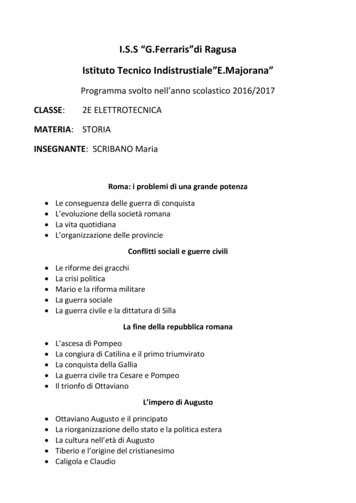




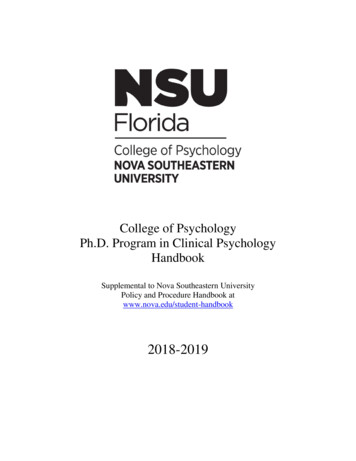
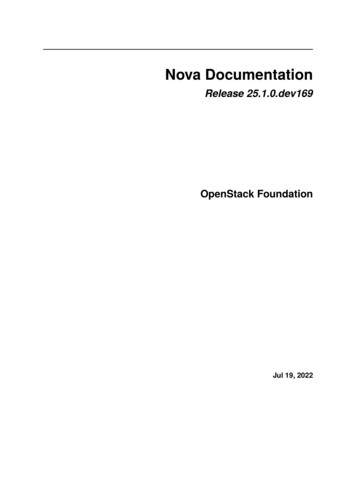
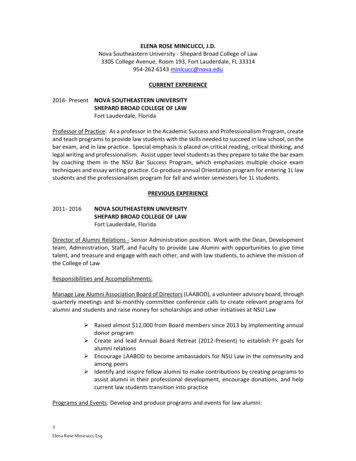
![Nova-Life Full Crack [Keygen] - Heroku](/img/60/novalife-full-crack-keygen.jpg)

